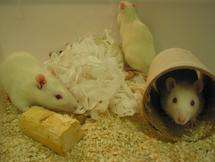Mouse genetic blueprint developed

Researchers have developed a valuable mouse genetic blueprint that will accelerate future research and understanding of human genetics. The international team, led by researchers at the Wellcome Trust Sanger Institute and the University of Oxford, explains in two papers published in Nature on 14 September 2011 how they decoded and compared the genome sequence of 17 mouse strains.
In creating this unique resource, the biggest catalogue for any vertebrate model organism, the team found an astonishing 56.7 million unique sites of variation (known as SNPs) between the strains, in addition to other more complex differences. Among these they identified sequence differences associated with over 700 biological differences, including markers for diseases such as diabetes and heart disease, so linking genes with medically important individual differences.
The catalogue, which was funded principally by the Medical Research Council and the Wellcome Trust, can be used by researchers to understand the genetic basis of individual variation, and to ask fundamental questions about how genes function and make us more or less likely to have particular diseases.
Inbred strains of mice are invaluable sources of genetic information. Every animal within each inbred strain is essentially genetically identical, but each strain is different from the others both in their genes and across a huge range of medically and biologically important characteristics.
"We are living in an era where we have thousands of human genomes at our finger tips", says Dr Adams, from the Wellcome Trust Sanger Institute, who led the project. "The mouse, and the genome sequences we have generated, will play a critical role in understanding of how genetic variation contributes to disease and will lead us towards new therapies."
As a direct result of the project, researchers will place less reliance on breeding mice to find mutations; using this resource they will be able to find mutations much more quickly by the click of a digital mouse to search for the data on their computer.
These strains of mice are used in every corner of biology to further our understanding of human disease, and there is much more to discover. With the variants to hand, the challenge moves to understanding the biological consequences.
"In some cases it has taken 40 years - an entire working life - to pin down a gene in a mouse model that is associated with a human disease, looking for the cause," explains Dr Thomas Keane, who was first author on one of the papers. "Now with our catalogue of variants the analysis of these mice is breathtakingly fast and can be completed in the time it takes to make a cup of coffee.
"We now know where all the variants are, so the questions today are what do they do, and can we explain the phenotypic differences between different strains of mice?"
Crucially, the resource will reduce the amount of mouse breeding and testing needed to identify genes and mutations, reducing the numbers of mice required for each study. The initial discovery can be made computationally. The extensive catalogue will be invaluable for associating variation in a trait with changes to DNA - the biologist's journey from phenotype to genotype.
Using the sequence of the 17 mouse genomes, the team looked for variants associated with quantitative trait loci (QTLs) implicating differences in the sequence between strains as being associated with the phenotypes that distinguish them.
"This study is a first step in a long path that moves from understanding what the genome is, to what it does," says Professor Jonathan Flint, from the Wellcome Trust Centre for Human Genetics, who co-led the study.
"The biological differences across the inbred strains of mice model variation between individual humans," says Professor Ian Jackson, joint head of Medical and Development Genetics at the Medical Research Council's Human Genetics Unit. "This resource, made possible through huge recent advances in sequencing technology, is transforming our understanding of how DNA sequence variation relates to gene function, and ultimately its association with biology and human health."
The project will be extended by sequencing further mouse strains, defining the genetic changes in mouse cancers and investigating the effect of variants on gene function.
The blueprint, coupled with today's speedier sequencing, enables researchers to probe deeper to find mutations affecting gene function at a much faster rate. It also opens the doorway to the possibility of sequencing much larger numbers of mice, with plans to extend the project to hundreds of mouse strains, a feat that only a few years ago would have seemed impossible.
More information: 1. Keane TM, Goodstadt L, Danecek P et al. (2011) Mouse genomic variation and its effect on phenotypes and gene regulation. Nature 477, 289. doi: 10.1038/nature10413
2. Yalcin B, Wong K, Agam A, Goodson M et al. (2011) Sequence based characterization of structural variation in the mouse genome. Nature 477, 326. doi: 10.1038/nature10432
Provided by Wellcome Trust Sanger Institute















